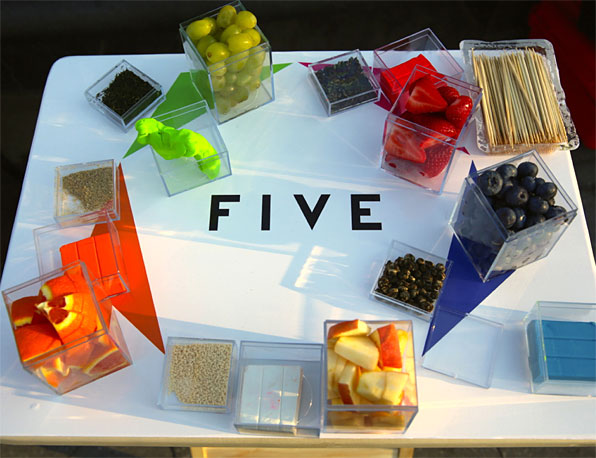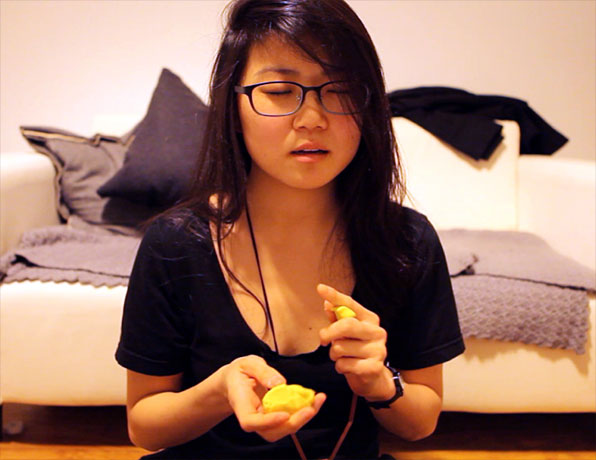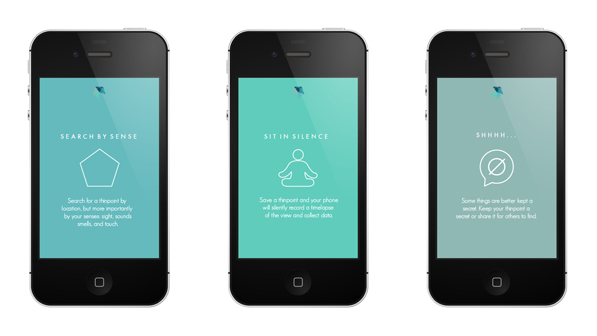Masters Thesis: Five+: An Exploration of Mindful Experience Through the Lens of Sense, by Cassandra Michel
Products of Design MFA student Cassandra Michel’s thesis titled “Five+: An Exploration of Mindful Experience Through the Lens of Sense,” started as a question of happiness and how happiness is achieved. She began by conducting research, discovering the philosophy of Mathieu Richard who proposes that happiness is a skill that is cultivated.
Cassandra also identified a 2010 Harvard research study conducted by Matthew Killingsworth and Daniel T. Gilbert which revealed that humans have a unique ability for mind-wandering. Mind-wandering is the ability to think about the past and the future, but can quickly lead to unhappiness. In the Buddha’s Brain, Neuropsychologist Dr. Rick Hanson contends “our vastly more developed brain is fertile ground for a harvest of suffering. Only we humans worry about the future, regret the past, and blame ourselves for the present. We get frustrated when we can’t have what we want, and disappointed when what we like ends. We suffer that we suffer.”
Further research uncovered that mind-wandering—in the form of distraction—is only exasperated by our digital age. Douglas Rushkoff, in his latest book, Present Shock, coins the term “digiphrenia,” arguing that by dividing our attention between our digital devices, we sacrifice the present moment. Cassandra speculated that in this age of distraction we might need a digital device to solve the problems created by these technologies. This paradox is exemplified in a speculative object she designed as part of her early exploration—a pendant necklace that transforms an analogue stethoscope into a digital device. It tunes out digital distractions, allowing users to tune in to themselves.
Cassandra reflected on the issues of mind wandering, worrying, and unhappy thoughts and realized how intangible these concepts are. She thought it might be helpful to make them physical in a simple way, and imagined the problem as a tiny critter that lives in the mind...causing havoc. She brought this critter to life in a stop-motion film. In the video, the main character, Tim, is constantly distracted by his critter, until one day he comes across a service called The Critter Cleansing and Cognitive Capacity Cultivation Company (C5Co) that introduces him to mindfulness and meditation techniques. The response to the video was instant and enthusiastic, and led to a follow-up experiment.
Cassandra asked peers to mold their personal “critters” out of clay, to describe to her what the critter says, and to try to articulate what features and qualities the critter has. The goal of the exercise was to create a taxonomy of critters, but through this research it became apparent that the act of molding the critter had therapeutic elements in itself. The tie to art therapy, which uses art as a medium for therapy, became apparent in the process.
There seemed to be many benefits: The action of stretching and shaping the clay was stress relieving; the tactile nature of the clay and its malleable qualities served as a helpful focal point for attention; the creation of the critter served as a conduit for conversation about stress and negative thought patterns; and finally, the ability to give the intangible nature of thought a visible form served as a useful metaphor. This led to a fundamental insight for the thesis: there could be other methods for practicing meditation—beyond focusing on the breath. And the tactile nature of the exercise pointed to the notion of focusing on the senses as focal points.
The practice of mindfulness is a 2500-year old methodology for cultivating attention and curbing the innate potential for becoming easily distracted. And promisingly, neuroscience is now proving that meditation practice can change the structure of the brain. According to Willoughby Britton, Assistant Professor of Psychology at Brown University, “the neuroscientific principle of experience-dependent neuroplasticity is one of the most important paradigm shifts in modern science and medicine. Rather than being fixed entities of unchangeable traits and behaviors, our brains and psychological tendencies are actually quite malleable, and can change with both experience and practice. Just as exercise and training strengthens physical muscles, mental habits construct and become entrenched in corresponding brain networks.”
Cassandra conducted further research into how senses shape our experiences and thus our neural networks and our brains. In “The Desert of the Real,” an essay by John Thackara, Cassandra discovered the work of philosopher and education reformer, KB Jinan, who proposes that there are two types of people: Text Cognites and Sense Cognites. Jinan believes that children are sense cognites and navigate the world primarily through the senses. This direct relationship with the senses allows for an authentic human experience. Jinan hypothesizes that adults need to reconnect with their own senses and use them as the primary way of understanding the world.
Rolling up this research, Cassandra conducted an experiment where she asked participants to meditate on their individual senses while molding clay, smelling teas, tasting fruit, and framing specific views. What she found was that the techniques that were more active than passive were more successful. Following this research, she designed another experiment that was highly active and integrated the senses of sight and sound. First, participants were asked to choose a sound related to a memory. They then sprinkled charcoal over a set of speakers and watched as the sounds created a visual pattern.
Cassandra took elements of her experiments further by integrating them into a sensorial and meditative group dinner. She built a unique dinner table with ten embedded speakers, replaced the charcoal from the previous study with food spices, and asked guests to submit recorded stories of their memories. Dinner guests were blindfolded and asked to participate in a guided meditation on the sound, smell, textures, and color of the spices. They then sprinkled the spices on the table, and when the sounds of their memory played, the spices danced across the table creating a moment of surprise and delight.
Finally, Cassandra conducted research into how environment can have an effect on the brain. According to neuroimmunologist Esther Sternberg in her book Healing Spaces, “When people view scenes that are universally preferred—a beautiful vista, a sunset, a grove of trees—the nerve cells in that opiate-rich pathway become active. It is as if when you’re looking at a beautiful scene, your own brain gives you a morphine high!” In an interview with Sternberg, she writes about the Celtic cultural term “thin places.” Thin places are locales where the space between heaven and earth is thinner. Cassandra asked herself how might she design a service that helped people find these unique locales.
As a final work, Cassandra designed a concept for a digital service. Thinpoint is a mobile app that encourages urban dwellers to go outside into nature and green spaces. The app provides users a way to pinpoint, archive, and share their thin points. Because these unique places are made up of sights, sounds, smells, and textures, Thinpoint allows users to search for them via their senses. For example, they can search for the smell of eucalyptus, or the sounds of crickets. When arriving at a thinpoint, users can choose to “save the spot,” wherein their phone will sit in silence by turning off notifications. It will also automatically capture a time-lapse of the view, along with other important data. Finally, users can choose to share the thinpoint or keep it a secret.
See more of Cassandra Michel’s work on her website www.cassandramichel.com, and email her at cassymichel[at]gmail[dot]com.
















